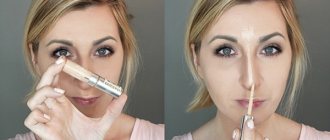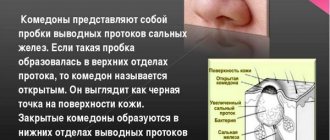A boil, or boil, is a purulent-inflammatory disease that develops in the hair follicle. The disease is caused by pyogenic microorganisms (Staphylococcus aureus bacteria). As the process of boil maturation progresses, the pathology covers the sebaceous glands and surrounding tissues, while the person experiences painful sensations and aesthetic discomfort.
The period of development of a boil lasts more than one day, but people want to get rid of the problem faster and therefore the question of how to speed up the maturation of a boil is quite relevant. But the abscess must go through all stages of its development; there is no need to open it ahead of time and try to squeeze it out, otherwise the recovery will be delayed indefinitely and there will be a risk of serious complications.
To make the boil ripen faster and the purulent masses come out, you can use medications, dry heat or folk remedies. But before starting treatment, it is better to consult a doctor and determine the reasons that provoked the formation of an abscess.
Stages of development
When a boil appears on the human body, a cosmetic defect is formed that you want to get rid of quickly. The neoplasm develops in several stages. In total, the boil matures in about 10 days.
Formation stage
The first stage of development is the direct formation of a pimple on the skin, which has a red tint and unclear boundaries. At first it is small in size, but over time it begins to enlarge, causing swelling and pain. The formation stage takes 3-4 days.
Pathogen reproduction stage
At this stage, the boil matures and the process of pus formation begins. The boil takes the shape of a cone, inside of which there is a purulent necrotic core. In the middle of the rash there is a white head. People often puncture and press on it to extract the contents. However, such actions are strictly prohibited.
When the process of suppuration occurs in the boil, a person may have a fever and general weakness. There are 3-4 days left before the boil opens.
Breakthrough and healing stage
After 7-8 days, the pimple matures and breaks out on its own without human intervention, and pus comes out. A crusty scar remains at the site of the abscess, which heals quickly within a couple of days.
Folk remedies
Alternative medicines have the same properties as medications; consult your doctor before using them.
- Apply the pulp of an aloe leaf cut lengthwise directly to the abscess, secure the compress with a bandage. Replace every 8 hours.
- Onion will help remove the purulent exudate; boil it in milk until softened, grind it into a paste and apply it to the boil under a bandage.
- The process of ripening and healing will go faster if you use this remedy - mix raw yolk with salt and honey (5 grams each), add flour to the mass and knead a soft dough. Form into a cake and place on top of the boil daily.
- You can apply slightly broken cabbage leaves to the site of the future abscess, fix the Kalanchoe on top with a bandage and leave overnight.
- Make compresses - dissolve a teaspoon of salt in a glass of hot water, soak a cloth in it and apply to the affected area.
You can treat the maturing infiltrate with antiseptic solutions (fucorcin, iodine, camphor alcohol).
Do not try to open or squeeze out the boil - the boil must go through all stages of its development, after which it will clear itself. Also, do not self-medicate with multiple skin lesions (furunculosis) - such a pathology requires proper antibacterial therapy.
If the boil cannot break through for a long time, and the painful symptoms are accompanied by an increase in body temperature, be sure to go to the doctor, most likely this will require surgical intervention followed by antibiotic therapy.
Actions after a boil breaks out
Quite often, the tumor breaks out on its own. If a boil has burst, you need to perform a number of actions aimed at disinfecting the wound and preventing complications. If the boil has opened, you must:
- Treat the wound with hydrogen peroxide to destroy pathogenic microorganisms.
- Apply a bandage. In order for it to have antibacterial properties, it is impregnated with sodium chloride. The gauze needs to be changed every morning if the purulent discharge does not come out immediately.
- Disinfect the skin around the pimple. This should be done every time the dressing is changed. It is allowed to treat with medical alcohol or other sterilizing substance. This manipulation will help prevent infection from entering the body.
- Remove the internal purulent core. It has a greenish tint. If the boil has burst, you cannot pull out the pus immediately after opening. You will need to wait for the moment when it begins to separate. To remove, use only sterile tweezers and wipe your hands with alcohol.
If these manipulations are carried out correctly, the skin at the site of the lesion will quickly heal, but a weak scar will remain. If there is any doubt that these steps were carried out correctly, it is better to immediately contact a dermatologist.
We speed up the process with medications
It will take at least a week before the abscess opens and completely clears itself. In order to shorten the time it takes for boils to ripen, after medical consultation, you can use the following medications:
- Vishnevsky ointment - make a compress (soak gauze cloth with the product), apply to the affected area, secure with a bandage. Change every 12 hours. The drug improves blood circulation, which promotes the rapid release of pus to the outside.
- Ichthyol ointment - cotton wool soaked in medicine is applied to the boil, covered with parchment on top and fixed. Replacement is done every 8 hours. An application made in this way will speed up the process of maturation of the pustule. At the same time, the product has a bactericidal and analgesic effect.
- Levomekol ointment is a combined drug with antibacterial and immunomodulatory effects. A cloth napkin is soaked in the medicine, applied to the boil and fixed.
If the boil does not mature, physiotherapy is performed, for example, ultraviolet radiation. You can warm up the affected area yourself - dry heat will speed up the process of formation of purulent-necrotic masses, and accordingly shorten the recovery time.
Possible complications
Removal of boils must be done in a timely manner and should be entrusted only to an experienced specialist in order to prevent the development of adverse consequences. Let's consider the complications that are observed after the operation.
Seal
The appearance of a dense area at the site of boil removal causes discomfort in patients. But there may be two scenarios for the development of events. Skin thickening appears even with a properly performed operation and proper wound treatment. This happens because the epidermis is damaged and needs time to recover. The dense area will resolve on its own within a month.
But sometimes compaction indicates incomplete removal of the purulent core. In this case, you need to consult a doctor. If the version is confirmed, the doctor will perform another operation. It is very important to completely cope with furunculosis. If it continues, new boils will appear on the body. The fact that the problem has not been eliminated is indicated by a deterioration in the general condition, the appearance of nausea, weakness, and drowsiness.
Traditional treatment
Single uncomplicated boils do not require any specific therapy - it is enough to wait for the spontaneous opening of the abscess and treat the opened wound with an antiseptic.
When a large mature boil cannot break through, seek medical help. The doctor will perform the following procedures:
- Apply a bandage with salicylic acid over the abscess - this procedure will soften the top layer of the boil and allow it to open;
- next, the doctor removes the necrotic rod (using a thin clamp);
- a latex drainage is placed into the opened wound to improve the outflow of purulent masses;
- applies a sterile bandage.
After about 2-3 days, the drainage is removed and the affected area is disinfected. If necessary, the doctor prescribes antibiotics.
The following groups of drugs are effective in the treatment of furunculosis;
- penicillin antibiotics - Amoxiclav, Ampiox;
- cephalosporins - Ceftriaxone, Cefotaxime;
- macrolides - Azithromycin, Sumamed.
Tetracyclines, Levomycetin, Gentamicin are also used - all these medications are active against Staphylococcus aureus bacteria.
Prevention
The main measure to prevent the formation of boils is following the rules of personal hygiene. You need to cleanse your skin daily, especially in hot weather when you produce a lot of sweat.
Prevention also involves the following:
- Choosing loose-fitting clothing made from high-quality materials that are highly breathable and do not cause chafing of the skin.
- Strengthen the immune system.
- Eat properly.
- Take vitamins.
- Do not overstrain the body.
In people suffering from diabetes, pathogenic microorganisms multiply faster and more actively. Therefore, such patients often develop boils. To prevent their occurrence, patients need to keep their glucose levels under control.
If the boil does not go away for a long time, you should see a doctor to find out why the tumor occurred and how to deal with it. If ignored, the pathology will bring pain and discomfort, and will also develop into chronic furunculosis.
Reasons for appearance
Staphylococcus, like many other bacteria, is part of the skin microflora and in ordinary life does not cause any harm. When favorable conditions are created, these microorganisms are activated, their numbers increase, and the result of their vital activity is a purulent-inflammatory process.
A boil, like any other abscess, can occur as a result of:
- decreased immunity;
- damage to the skin (bacteria penetrate inside through microtraumas);
- excessive sweating combined with poor or complete lack of personal hygiene;
- metabolic or hormonal imbalance;
- dysfunction of the endocrine system;
- chronic infectious diseases;
- hypothermia.
The formation of a pustule is preceded by a combination of unfavorable factors developing against the background of reduced immunity.
The best ways to treat a boil at home and quickly: how to treat a boil correctly
A furuncle is a purulent inflammation of the hair follicle around the hair root, it spreads to nearby tissues. Treatment for a boil depends on:
- stages of the disease (there are three of them);
- location of the abscess;
- boil size;
- age of the patient;
- presence of concomitant diseases;
- physiological characteristics (for example, pregnancy).
Treatment of chiria can be conservative and operative (surgical). The doctor decides whether to open the boil or use external remedies to speed it up. In conservative treatment of an abscess, the entire arsenal of treatment methods is used, and after surgery, wound healing is accelerated with the help of medications.
How and how to treat boils quickly and effectively. Top 7 ways
Before you look for ways to treat a boil, you need to make sure that this is it. So, swelling on the eyelid is a stye or chalazion and you need to contact an ophthalmologist. Possible ulcers on the eye are extremely dangerous, as they are close to the brain.
It is also necessary to distinguish between inflammation of the sweat glands and boils under the arm: an abscess with hidradenitis has a different shape, usually multiple, and ripening lasts about two weeks (instead of 3-4 days for an uncomplicated boil).
Boils appear where there are hair follicles - on the leg, arm, and other hairy parts of the body. A boil cannot occur on the palms and soles, or mucous membranes (the exception is the nasal mucosa; there are small villi on the inner lining of the nose).
Other types of purulent inflammation may require other types of treatment. If you apply even the most effective method for combating boils to them, it may be ineffective or lead to complications (which will worsen the situation).
Treatment with ointments
Ointments are the medicine most often used when treating a boil at home. They are used at all three stages of boil development:
- aging;
- opening;
- healing.
At the ripening stage, ichthyol ointment is effective; it helps to quickly and safely “open” the boil in adults and children. The product has no contraindications.
Vishnevsky ointment is a time-tested remedy that helps draw out the pus remaining in the cavity and speed up granulation. You can use it before opening the boil; according to reviews, this is a universal remedy that is used from the beginning to the end of the treatment of the boil.
Levomekol is placed into the opened cavity; this ointment successfully fights bacteria and helps heal the wound left after the pus is released. The advantages of the product include the fact that it allows air to pass through and does not create a dense film under which pathogenic anaerobic bacteria can settle.
Ointments containing sea buckthorn oil actively heal wounds after boils.
Traditional medicine
Advantages: availability and harmlessness. These products contain only natural ingredients, which makes them possible to use during pregnancy, when medications are not recommended.
Most often, boils at the ripening stage are treated with onions: bake a cut onion and apply it warm to the abscess.
Long before the invention of ichthyol ointment, birch bark was burned to treat boils and the resulting mass was applied to the inflamed area.
A very effective folk remedy is cabbage leaf: it is dipped in boiling water, scalded to soften it and applied to a ripening boil.
In almost every home there is a pot of aloe on the windowsill: the fleshy leaves of the perennial plant help draw out pus and promote wound healing.
External treatment with alcohol solutions (antiseptics)
At the initial stage, you can avoid the formation of an abscess if you lubricate the inflamed area of skin with an alcohol solution of iodine, boric alcohol, and other alcohol-containing antiseptics. Wiping should be done strictly from the edges of the inflamed area to the center, so as not to enlarge the lesion.
Boils on the head are wiped with salicylic alcohol. This procedure is detrimental to pathogenic microorganisms, and in addition, wiping with such solutions causes local heating of the tissues and a rush of blood. This helps eliminate the inflammatory process.
Doctors also recommend treating the edges of the wound after opening the boil, when a turunda (gauze swab) is inserted there, with Chlorhexidine.
Compresses, bandages with constant moisture and turundas
The ruptured boil is cleared of pus using gauze bandages irrigated with a hypertonic (10%) solution of table salt: a ball of gauze is placed on top of the wound, which is fixed with a sticker, and moistened with the solution every 3-4 hours.
This draws out the remaining pus well.
Clinical studies have shown that applying such dressings has an effect even when the purulent core has not yet come out: 2-day use of a hypertonic solution accelerates the process of boil maturation and its breakthrough.
To make the boil burst faster, apply compresses with silver nitrate.
Turundas are made from bandages or pieces of gauze twisted into a tourniquet. They can be administered to absorb pus and ichor on any part of the body - on the back, stomach, etc.
A bandage or gauze is moistened with the same salt solution or lubricated with ointments for insertion directly into the opened cavity, which is a narrow “crater,” or at the stage of infiltration into a natural narrow cavity (nasal cavities, ear canal) in order to accelerate the maturation of the abscess.
The top of the wound is bandaged. If the location does not allow bandaging (for example, a boil on the buttock), the entrance to the cavity is covered with sterile gauze and sealed.
Warming up
How to treat a boil at the initial stage, when redness and slight swelling just begin? In this case, heat helps: warming the skin (especially deep), for example, with a bag of salt or an egg, strengthens the body's defenses, reduces inflammation and soreness.
Wet compresses for warming during ripening are not recommended. But when the abscess has broken through, the technique of intermittent warm compresses is used, gauze moistened with a warm medicinal solution (soda or saline) is applied once an hour for 15 minutes.
You can use the UHF, Sollux and other heating procedures; they are carried out in clinics.
Tablets, injections (antibiotics, painkillers), autohemotherapy
Antibiotic treatment should be started if:
- large boil (diameter exceeds 5 mm);
- there is a sharp and strong increase in temperature, the patient has a fever;
- a person has more than one boil.
Antibiotic drugs should only be selected by a doctor, since there are types of staphylococcus that are resistant to antibiotics (they are called methicillin-resistant).
How to treat such boils:
- Doxycycline;
- Minocycline;
- Clindamycin.
If the temperature is high and there are multiple boils, Rifampicin is added to systemic antibiotics, all this orally (tablets). Treatment can be carried out at home.
In hospital settings, especially with common staphylococcal infections, intravenous injections of Clindamycin and Linezolid are used.
An antibiotic solution is used for blockade in combination with Novocaine and other anesthetics: several injections are made around the inflamed area.
This method not only quickly reduces inflammation, but also reduces pain.
This is especially true if the boil has “grown” in a place rich in nerve endings (for example, the tailbone), or is located where it is constantly exposed to friction or pressure (on the neck, under the knee, etc.).
Treatment with gamma globulin also involves injections; they are prescribed if boils occur with reduced immunity. In severe cases, immunotherapy is performed using a staphylococcal vaccine.
Surgical method
Indications for surgical intervention are:
- an abscess that did not open within a week after using conservative measures;
- complications (phlegmon, abscess, inflammation of the lymph nodes and lymphatic vessels - most often this occurs when the boil is localized in the groin);
- absence of a purulent head with an increase in the diameter of the boil;
- high temperature, fever.
It is recommended to seek the help of a surgeon if a boil appears on the face in the area outlined by the nasolabial folds, upper lip and bridge of the nose (“triangle of death”), near the eyes, inside the nose. If the boil is localized on the lip, timely surgical intervention will help avoid disfiguring scars.
Which doctor should you go to if nothing helps?
You need to contact a surgeon to open the abscess in cases where:
- The red swelling increases in size, but the purulent head does not appear - this is a sign that purulent melting of the deeper tissues has begun and an abscess boil has formed.
- Reddish stripes extend from the boil to the sides, which indicates the onset of inflammation of the lymphatic vessels.
- Next to one abscess, a second or more began to “climb out.” Multiple boils degenerate into a carbuncle, which is fraught with very serious complications.
A visit to an otolaryngologist is necessary if the boil is localized inside the nasal passage or in the ear, where the patient cannot see the condition of the abscess and treat it independently.
Real reviews
Marina:
“The youngest son began to catch colds often and the child constantly had boils. We applied aloe leaves and lubricated it with ointments, and followed all the instructions. But all the same - one passes, another appears immediately.
The doctor said that my immunity is low and I need to toughen up. And to recover, they injected him with gamma globulin.
The boils have gone away, we are now gradually doing hardening and rubbing, our health has improved and there are no colds either.”
Alexandra:
“There is nothing better than a good old home first aid kit and folk remedies! Even during pregnancy, boils periodically broke out, once even on my stomach.
The doctors did not recommend chemical treatment so as not to harm the child, so my mother applied a baked onion, cut in half, to my abscesses. It was enough to bandage the bow overnight so that it would break in the morning.
Later, after giving birth, I had boils a couple of times due to low hemoglobin, and again the onion helped. Now that I’ve already fed the child, I can treat myself with medications, but I prefer traditional medicine.”
Sergey:
“As I “plunged” into wormwood while winter fishing and was thoroughly frozen, after pneumonia, furunculosis began: boils popped up literally one after another all over the body, and before one had time to cure, the next one ripened.
Doctors said that this was due to a weakened body due to pneumonia, and antibiotic treatment also took its toll. The condition improved slightly with the help of old proven means - ichthyol, Vishnevsky's liniment.
But then I had to undergo blood transfusions and treatment with injections of my own blood. My health has improved and I was able to cope with boils.”
Igor:
“When the first boil in my life appeared, I did not experiment, I went to the doctor. There was nothing to open there; the purulent head had not yet “unscrewed”.
Therefore, with the help of ichthyol ointment, I “brought the boil to maturity”, and when the pus burst and the rod came out, I put in levomekol. A very good ointment, all the nasty stuff was pulled out, and the wound healed, although it was deep (on the butt).
They told me to use bactericidal soap and avoid hypothermia.”
Angelina:
“I made a mistake when I decided to squeeze out what I thought was a ripe boil on my own.
Not only was it terribly painful, but the pus did not come out, but on the contrary: the boil became gigantic, throbbing and painful, and my temperature rose. I had to call a doctor.
As a result, we went by ambulance to the hospital, where the surgeon opened this abscess, and then I went to get dressings. But it healed quickly, thanks to the ointments, and the scar remained completely invisible.”
Source: https://netpryshi.ru/furunkuly/lechenie-furunkula.html
When to see a doctor
The development and maturation of the boil lasts about ten days. An unripe boil or a boil that has matured for more than seven days is the main sign that you should immediately seek help from specialists. Complications arise when a chiryak is opened in the deep layers of the skin. This causes the spread of infection, which provokes the development of a severe form of furunculosis.
When you contact a doctor, tests will be ordered, based on the results of which hospital treatment or surgery will be prescribed.
The article has been verified by the editors
Surgical intervention
If a woman (man) realizes that the abscess will not open on its own, it is necessary to urgently consult a doctor - a deep subcutaneous abscess requires surgical intervention. Otherwise, the boil can break into the anatomical cavities, and this is fraught with complications including sepsis.
Surgical treatment is performed under anesthesia, most often local anesthesia is used. The boil is opened and drained, completely removing all purulent contents. Next, the wound is disinfected and stitches are applied if necessary. The patient should remain in the hospital under the supervision of a doctor for several days after the intervention.
In the postoperative period, the patient undergoes antibacterial therapy with local or systemic drugs. For better healing and to prevent further relapses, it is recommended to undergo a course of physical treatment.
Please understand that self-medication can be dangerous, so consult your doctor first before doing anything.











